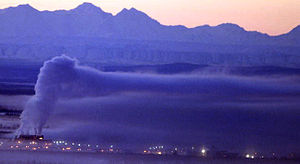Ice fog is a type of fog consisting of fine ice crystals suspended in the air. It occurs only in cold areas of the world, as water droplets suspended in the air can remain liquid down to −40 °C (−40 °F). It should be distinguished from diamond dust, a precipitation of sparse ice crystals falling from a clear sky.[1] It should also be distinguished from freezing fog, which is commonly called pogonip in the western United States.
In the United States

Ice fog can be quite common in interior and northern Alaska, since the temperature frequently drops below -40° in the winter months. Ice fog only forms under specific conditions; the humidity has to be near 100% as the air temperature drops to well below 0 °C (32 °F), allowing ice crystals to form in the air. The ice crystals will then settle onto surfaces.
Supposedly, early settlers called it "white death" because they believed the crystals got into their lungs and caused death.[2]
References
- ^ "AMS Glossary - Ice fog". Retrieved 2015-07-07.
- ^ Beware the Dreaded Fog Irish Times